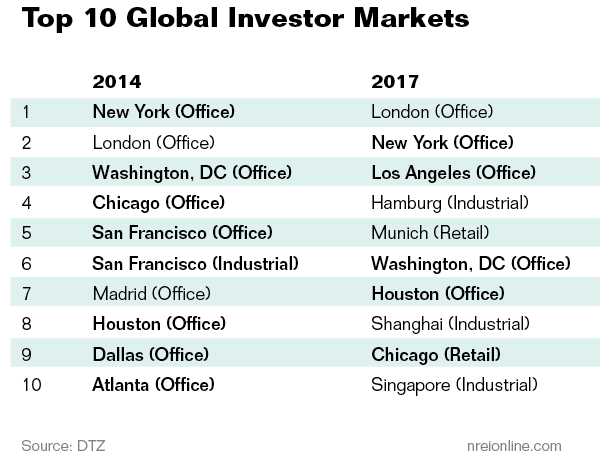U.S. office markets dominated the fieldof top global investor markets in 2014, grabbing seven of the top 10 spots. Although that dominance is expected to slip in 2017, New York, Los Angeles, Washington, D.C. and Houston will continue to rank among the top 10 markets for investors, according to new research from real estate services firm DTZ.
In 2014, office markets in New York, Washington, D.C., Chicago, San Francisco, Houston, Dallas and Atlanta all made DTZ’s top 10 for global investment markets, while San Francisco also ranked in the top 10 for its industrial market. What is notable is that there are no Asian markets and just two European markets in the top 10 ranking, with London’s office in the number two spot and Madrid’s in the number seven spot.
DTZ’s three-year forecast predicts that U.S. cities will continue to rate high on the list, but their presence in the top 10 will be challenged by both European and Asian cities going forward.
“In 2017, we see a broader mix of markets in terms of regions and sectors,” says Hans Vrengen, global head of research at DTZ.
DTZ, which analyzed 60 different markets globally, released its results on December 4. Some of the key factors that go into its investment “scorecard” include transaction volume, property values, market timing related to the position of values compared to the market peak and market volatility.
So, why does U.S. office sector have such a dominant presence globally? Transaction volumes for office properties in particular are a key driver in the overall rankings.
“We typically see higher office volumes relative to the volumes in both retail and industrial markets across the U.S.,” says Nigel Almond, head of capital markets research at DTZ. Office sales in the U.S. reached $94.1 billion year-to-date through October, which is significantly higher than the $66.7 billion in retail sales and double that of industrial sales that occurred in the U.S. during the same period, according to data from Real Capital Analytics (RCA), a New York City-based research firm.
For example, the New York office market is entrenched as a top global investment market with the number one spot in 2014 and a number two spot in 2017. “That is because of its strong trading volume,” says Almond. The Washington, D.C. market also rates high for its transaction volume, with the number three spot in 2014 and a forecast for a number six spot in 2017.
Taking transaction volume out of the equation, Chicago’s office market would actually rank above New York’s and D.C.’s, notes Almond. For example, in New York, the high transaction volume helps to offset higher volatility. Manhattan alone recorded $15.2 billion in office sales during the first three quarters of 2014, according to RCA. Washington D.C., including Virginia and Maryland suburbs, reported office sales of about $4.5 billion during the same period.
In addition, despite cap rate compression, DTZ believes that all U.S. markets it analyzed are currently under-priced based on its fair value analysis.
“This means that many (U.S.) markets are high in our global rankings,” says Almond. Those results are also reflected in the narrow spread between the top- and bottom-ranked markets in the U.S. For example, the “scores” of top investment markets such as New York and Washington D.C. rate in the mid to high 70s, while bottom-ranking markets such as Denver are in the high 50s and low 60s.
Office markets clearly dominate the global investor rankings in both 2014 and 2017. However, DTZ expects office markets in Chicago, San Francisco, Dallas and Atlanta, as well as San Francisco’s industrial market, to move out of the top 10 in 2017. They will be replaced by U.S. additions that include the Los Angeles office market and Chicago retail market.
In addition, DTZ predicts a broader mix of markets in terms of regions and sectors to rate highly among global investors three years from now. Second tier industrial markets in both Europe and Asia are expected to move higher on the list.


